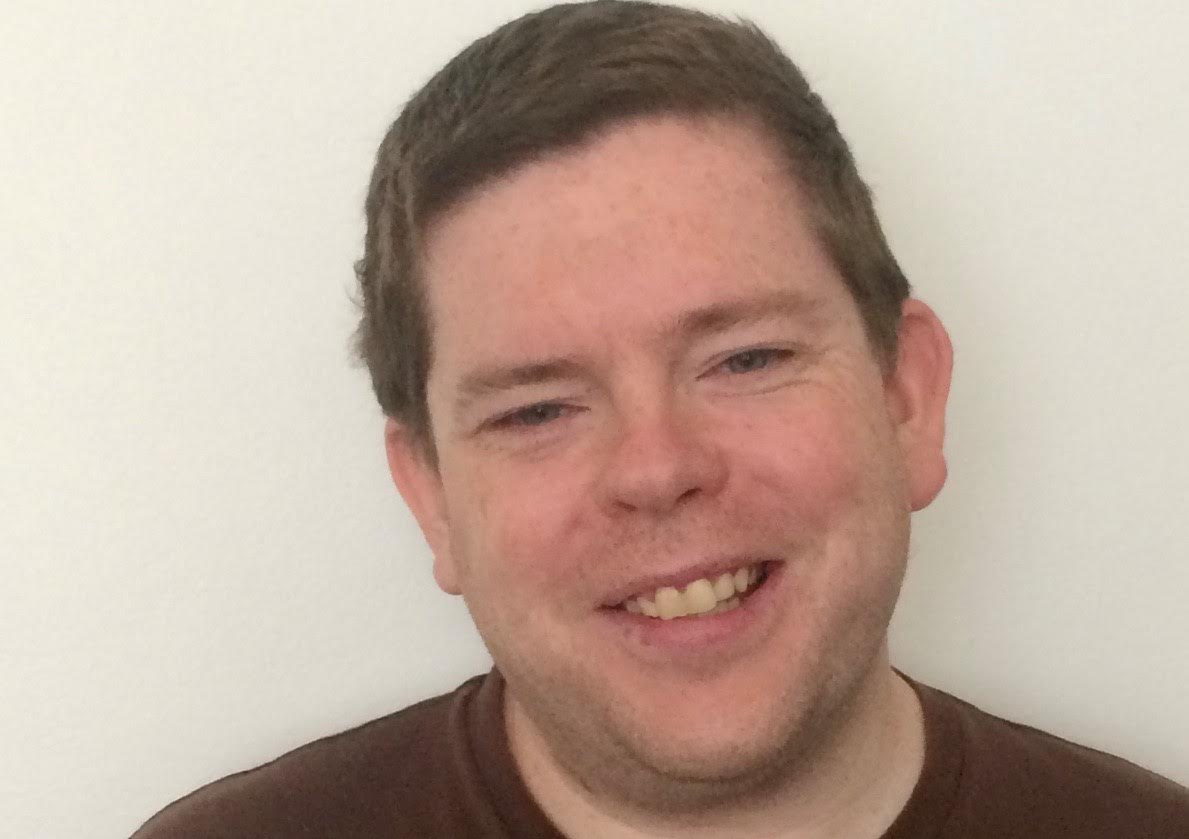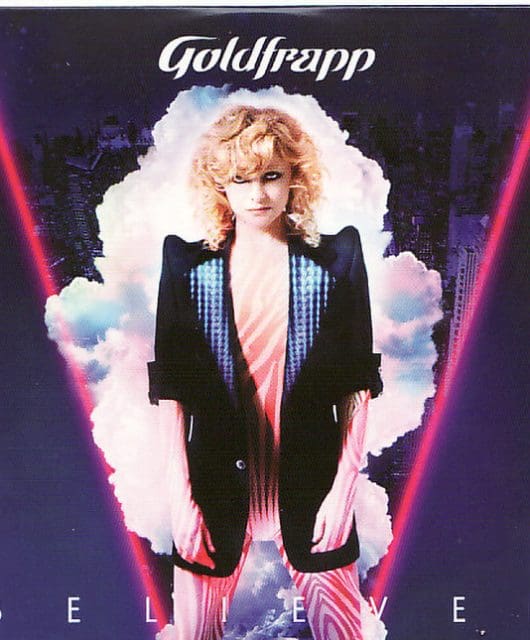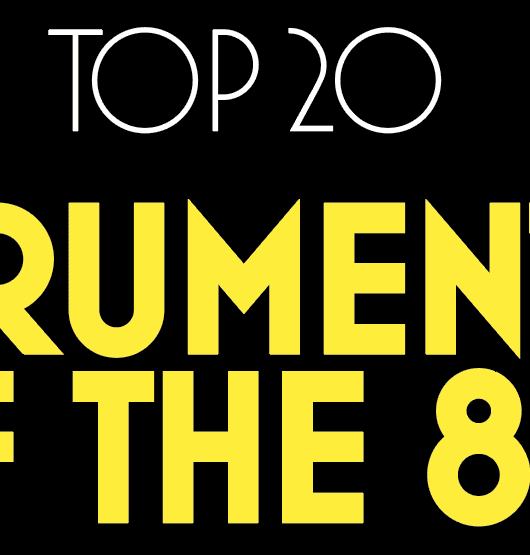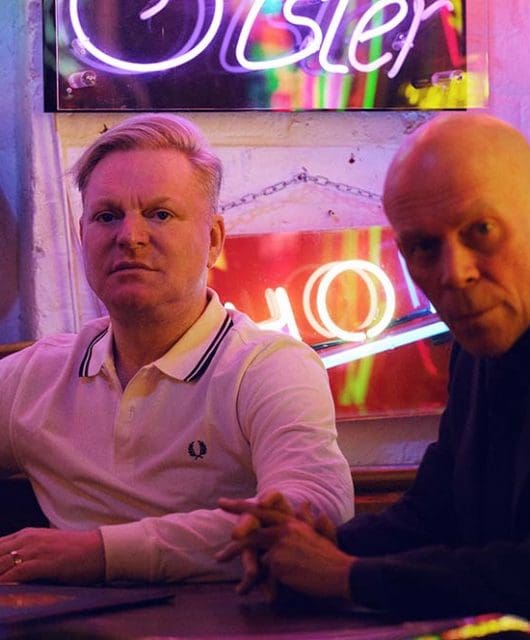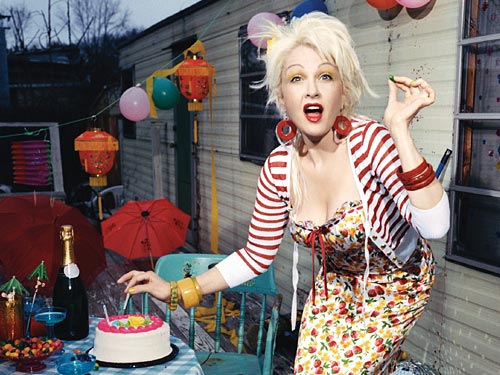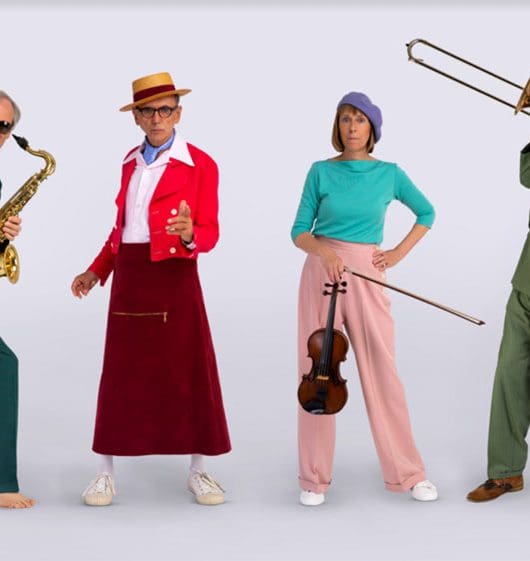Marc Almond interview (Exclusive)
By John Earls | July 9, 2021
Recently, Marc Almond has been talking of retirement. Are we really about to see one of our best-loved stars stride towards the exit? The former Soft Cell vocalist tells all in this exclusive Marc Almond interview…

The fate of Marc Almond is perfect material for one of his torch songs: the singer who wanted to quit music, but is in love with performing too much to step off the entertainment carousel. Last year, Marc hinted on Twitter that he was about to begin a prolific spell of work over the next two years and then it’d be a case of “Goodbye, wasn’t it all marvellous?” as he slipped off quietly into the sunrise.
Asked whether his dramatic new album Chaos And A Dancing Star really is the beginning of the end and Marc laughs ruefully. “Oh, I’ve been talking about retirement for ages,” he smiles, in our exclusive Mark Almond interview. “I can’t really leave music behind, and I’ve come to terms with that. I do sometimes think I’d like to live a little more life. I was thinking, ‘I’ve not got enough of a life to write about in songs.’ I had the bucket list of places I’d like to go, things I’d like to do, and wondering if I was going to get the time. I’m constantly working.”
In a previous Classic Pop interview as a solo artist for his 2015 album The Velvet Trail, Almond talked about his work with Chris Braide, the pop titan who’s produced Sia, Lana Del Rey, Beyoncé and any other recent megastar you can think of.
Their collaboration resulted in Marc’s best pop songs in years, and he’s stayed busy since: covers LP Shadows And Reflections, making an album with Jools Holland, the small matter of reuniting Soft Cell… Marc could be forgiven for wanting to slow down.
“I don’t know what else I’d do,” he admits. “As an older artist, I realise if I sit down for too long, I won’t stand up again. The worst thing I could do now would be to take a big break, because I’m on this merry-go-round that’s so constant, it’s hard to step off. And I’m scared to step off because, if I try, it’d be really hard to step back on again. You’ve got to keep working.”
Marc’s talk of being “an older artist” at 62 is at the heart of Chaos And A Dancing Star. Death has been a constant theme in Almond’s work, but in the gothic maelstrom of Soft Cell and his dark and deviant side-project Marc And The Mambas, mortality mainly came out in a whirlwind of narcotics and toxic sex.
On the new record, Marc addresses being in, as he terms it, “my final decades”. Opening ballad Black Sunrise is a post-apocalyptic love song; melancholic finale The Crows’ Eyes Have Turned Blue has Almond questioning, “Was it all for nothing?” as he informs a lover that “Our time comes to an end, there’s no time for me and you.”
Marc Almond interview: The end of days
In person, Marc is remarkably cheery about it all. He’s always been a delight to interview – attentive, trying to find the right words, honest but also quick to laugh at himself and the world around him.
In a suite at boutique hotel L’oscar next to Holborn tube station, Almond is dressed casually in a black fleece, looking well for someone facing up to his own mortality. “There seems to be an end-of-days feeling around,” he ponders. “That’s both generally and for me personally.
“In these new songs, I’m looking at the world around me and myself in the mirror and, really, I’m dancing through the chaos of it all.”
The title of Chaos And A Dancing Star is taken from a quote by the philosopher Friedrich Nietzsche: “One must still have chaos in oneself to be able to give birth to a dancing star.” It’s mentioned in the album’s near-title track Chaos.
“I love that quote,” Marc smiles. “I see it as meaning ‘out of turmoil comes creativity’, so I think it’s a positive statement. It’s how I feel about myself; dancing through chaos, hoping something positive will happen. Anyway, I’m happy that I must be one of the first people to put Nietzsche into a pop song!”
Chaos is a remarkably catchy pop gem for one based around nihilism, but that sums up the album: for all its post-apocalyptic landscapes, there are some absolute bangers on there, too. “It was important not to just get too doomy,” says Marc. “I didn’t want it all to be emotionally gothic and dark.”
If it’s not all gothic and dark, those elements are certainly there on the record. Chevrolet Corvette Stingray sees Marc fall for a sociopath, a classically handsome guy but one with all the emotional capacity of an automobile.
“Oh, it’s total autoeroticism,” laughs Almond delightedly. “They say the car industry must have got poets to think of the names of those old American cars: Chevrolet, Corvette, Stingray, Buick, Electra, such fantastic names. As for the sociopathic element? I’m very good at spotting them, though I do seem to attract them. Maybe that’s because I’m a little bit of a sociopath myself. I’m definitely narcissistic, which is one reason I find getting old so hard. Fighting a war with ageing and losing it, that’s a hard thing for a narcissist to contemplate.”
He’s laughing as he says it, but Marc quickly turns more serious. He sees the anti-hero in Chevrolet Corvette Stingray as “an idealised version of myself” – and that includes the emotional coldness. Marc hasn’t spoken about it publicly before, but one of the lasting effects of his near-fatal motorcycle accident in 2004 was a dampening down of his emotions.
“Ever since the accident, I’ve had a great battle with emotions,” says Marc. He says it calmly enough, as if he’s been wanting to talk about the effects for some time. “I have trouble trying to locate my emotions and I have a lack of empathy in how I feel towards humanity. I’ve always been a little bit like that, but the accident messed up a lot of my emotional feelings.
“The legacy it’s left is constantly trying to find the emotion in anything. I get emotional about things I shouldn’t get emotional about, but I have a lack of empathy for the things I should feel empathy for. I’ve a big lack of empathy towards people, but if I see a little dog being hurt, I can cry for hours.”
Read more: Top 20 reunion albums
Top 20 80s collaborations
Asked how it’s affected his relationships, Marc freely admits: “I find relationships very hard, to be quite honest. Not friendships, because the friends I’ve always had, they know what I’m like. The way I feel now, it’s something I’ve tried to put into these songs – the coldness I sometimes feel about things. There’s a fake emotional coldness in me.”
Marc Almond interview: At peace with solitude
Marc’s attitude to love is summed up in new single Slow Burn Love. One of his finest pop waltzes, it’s got a chorus as irresistible as anything he’s ever crafted. It describes wanting a lover who doesn’t get too close, happy to instead always be on the edges of proper commitment. It’s essentially autobiographical.
“For me, the best relationships are ones that almost never happen,” Marc smiles. “You never quite get there, but you always have it as a presence, as something exciting.” Another conspiratorial laugh.
“The best relationships I’ve had are always with someone in another country, because you barely ever see them! Seeing someone once in a while, that’s enough for me. I’m very much a person who likes to be on their own. I like
the idea of a relationship, but the reality is different, so I like a slow burn love that’s so slow it almost doesn’t happen.”
Marc is frustrated about one aspect of Slow Burn Love, however, confessing: “There’s a deliberate mistake in the lyrics, which I thought was a very good idea at the time, but it looks like everyone just thinks I’ve messed up. The line ‘The sun flies around the earth until it dies’ is meant to highlight how impossible the relationship is and that it couldn’t possibly happen. But, so far, people have just said to me, ‘Oh, Marc, you’ve made a huge cosmic mistake here.’ For the record, I know it’s the earth that goes around the sun, thanks everyone!”
The song that ties the threads of darkness, love and romance together on Marc’s new album is the sumptuous ballad Hollywood Forever.
It’s named after a cemetery in Los Angeles, where celebrities including Judy Garland, Rudolph Valentino and Cecil B DeMille are buried. Marc wrote the song while working in California with Chris Braide at his studio near Malibu.
“Hollywood Forever is a suicide song about the yearning for nostalgia,” Almond explains. “The golden age of Hollywood is certainly lost, and the Hollywood Forever graveyard is my favourite place to go in Los Angeles. It’s a beautiful place, and I wrote the words while walking around the mausoleums of all these great stars.”
Marc recorded his first three albums in New York, as well as 1996’s Fantastic Star, but has come to appreciate the charms of its West Coast cultural rival more as he’s got older.
“I loved the energy, the art scene and the music of New York when I was working there,” Marc remembers. “I was never much of an LA person at the time, but I look for a different energy now and Los Angeles excites me much more
these days.”
It’s precisely because of Marc’s retirement wish-fulfilment that he enjoys the LA life now. “There’s a great decaying feel to Los Angeles,” he says. “Lana Del Rey really captures that ennui of Los Angeles in her songs. I also like being there because nobody cares who you are. You can be as visible or as invisible as you like. I like the idea of going there so I can pad about in flip-flops and a dressing gown, a pair of dark glasses on, while I slowly decay along with
the rest of Hollywood.”
That Marc found time to go to California to work with Chris was indicative of the importance of their relationship. Chris not only grew up a Soft Cell fan, he sang backing vocals on their comeback album Cruelty Without Beauty in 2002: before becoming a superstar producer, Braide was a solo singer whose 1993 debut album Chapter One was produced by the unlikely pairing of Thomas Dolby and Mick Hucknall.
Their relationship began when Chris sent Marc some songs out of the blue he’d written, which he thought Marc would be ideal to sing on. Braide was right, and The Velvet Trail soon emerged.
“Chris and I tune into the same things,” Marc explains. “We’re both mad T-Rex obsessives. We often send each other playlists of the music we’re listening to. Chris knows how to make songs that are a good setting for my voice and he knows what excites me.”
Marc believes he and Chris have more chemistry than anyone he’s worked with since Dave Ball in Soft Cell. “I’ve written great songs with other people,” he accepts. “I really like working with my guitarist, Neal X, but I write better with keyboard players than guitar players.”
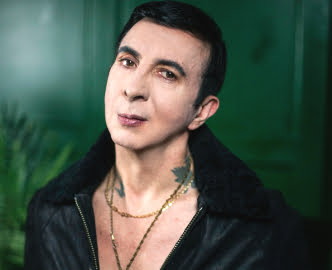
Marc Almond interview: Secret progger
The initial idea for Chaos And A Dancing Star was to make a prog rock record. Marc had dabbled with the genre shortly before The Velvet Trail, making the song cycle The Tyburn Tree in 2014 with composer John Harle about a secret mystical network in London.
“Chris and I are both secret proggers,” laughs Marc. “We wanted to make a record where the songs would blend into each other and there’d be other extracts linking their stories. It was an exciting idea, because it was so unfashionable and against the grain to make.”
The album’s first single Lord Of Misrule was written around those early sessions, a song so prog it features a flute solo by Marc’s friend Ian Anderson from Jethro Tull. But, having continued writing straight after The Velvet Trail, Marc and Chris’ second album together then had to wait.
When he signed to BMG, Almond was asked to make a covers record before a new album. “That was a bit frustrating,” Marc admits. “But I understood it, and BMG has been a good home so far.”
And then Soft Cell reformed. Marc and Dave told Classic Pop in 2018 how Universal’s idea for the Keychains And Snowstorms boxset marking 40 years since their first show led to Universal exec Mark Wood asking Marc if he’d consider seeing Dave for a coffee, 14 years since their last meeting, to discuss a tour ended with Almond shouting at Ball in the street.
“It had been frosty, to say the least,” Marc says now. “That was my fault, as I was in a very dark place, recovering from my accident.”

Once they were in the same room together, the idea of a one-off farewell show soon emerged. Before you knew it, Soft Cell were playing The Art Of Falling Apart and Sex Dwarf to 20,000 people at London’s O2.
“That was an amazing night,” says Marc. “We had very little rehearsal or technical time, so everything had to come together on the night – what you saw was our only real chance at it and I wish I’d been able to be in the moment more, to enjoy it there and then. But, amazingly, most of it did come together.
“There were a couple of glitches – we over-ran and had to drop a couple of songs, but it was a special night. For Say Hello Wave Goodbye at the end, everyone’s mobile phones lit up, it was a magical moment. Really, it was just lovely to be on stage with Dave again.”
Classic Pop suggests it was all in the spirit of Soft Cell’s shows first time around.
“A little bit chaotic, you mean?” Marc responds, looking archly over at your writer, before bursting out laughing. “It really was! It became a three-hour Bruce Springsteen-type show, because you had to please the electronic contingent, the goth contingent and the people who just wanted to hear Tainted Love and Say Hello Wave Goodbye. But I think we pulled it off.”
As documented on the live album Say Hello Wave Goodbye, the O2 reunion was indeed a triumph. But with that and Jools Holland duets LP A Lovely Life To Live, Almond and Braide needed to regroup when they were finally able to work properly together again.
“The prog idea developed into a more ballad-led record,” says Marc. “Even when Chris and I went off in different directions, we’d stay in touch, with Chris sending me tunes and ideas. The themes of the songs remained the same.”
Enjoying our Marc Almond interview? Read our Sigue Sigue Sputnik interview
Read more: Pet Shop Boys: Actually
The singer quickly deflects the idea that, with so many of his different sides featuring on the record, Chaos And A Dancing Star could be the definitive Marc Almond album. “I didn’t set out to do a definitive album,” he insists. “I hope every album I make is the statement I’d wanted at the time. But once you make your definitive album, you don’t have to make anything else after. That’d be it and I really would have to retire!”
Marc Almond interview: Goodbye twitter
If he’s definitely not retiring, Marc has walked away from one public side of his life: last September, he quit Twitter, a row about transgender politics hastening his exit.
For someone at the apex of sexual equality in the 80s to suddenly be accused of being transphobic for saying he was concerned at the number of labels people were defined by seemed unfair. He seems relieved to have left, rather than angry, his tone merely mildly frustrated and faintly amused at why he left Twitter.
“It’s very toxic now,” Almond reasons. “Things like irony, nuance, sarcasm and humour don’t come over very well. I liked being provocative and mischievous on Twitter, putting something out there to see what happens. But we now live in such a strange, divided, black and white world that, if you put an opinion out there, you have to be on a tribal side. You can’t be in the middle anymore.”
Marc compares his Twitter role as that of the provocateur in Lord Of Misrule, explaining: “I have the urge to say things I shouldn’t say – put the bombshell out there and see what happens. I like to create that chaos. But Twitter had stopped being fun and I can’t deal with very much hate these days.
“People don’t just disagree with you, you’re immediately a traitorous person who should just die. You can’t talk about disgust in any kind of grey area, nor can you explain that you’re being provocative. I’ve been through too much hate in my life. When Robbie Williams came off Twitter, he said, ‘You’re only one tweet away from a career-ender.’ I know how he feels!”
If anyone wants to carry on following Marc on social media, there’s always Instagram. “Instagram is less toxic and there are a lot of great visual ideas there,” he smiles. “I do Instagram for myself more than anything. I put up photos which are for the public, too, but mainly it’s to remind me what I did last week! I can’t remember otherwise, but now I can scroll back and go, ‘Oh yeah, I went there last year!’”
If, in his sixties, Marc Almond struggles to remember his recent escapades, he’s much clearer on his future now he’s got his desire for work back. He and Chris Braide are continuing to write together.
Against Nature, an opera the singer is planning based on JK Huysmans’ decadent 1884 novel which inspired Oscar Wilde’s The Picture Of Dorian Gray, has moved from a Kickstarter project to being developed with London’s Barbican Centre and, potentially, Sydney Opera House.
Oh, and Marc is making a new Soft Cell album with Dave Ball. “Our new songs are coming slowly but surely,” says Marc. “It’s slower my end than from Dave, who’s sent me some great tunes over. I’ve been thinking, ‘I know I’ve got to write something as good as this’ and, now Chaos And A Dancing Star is finished, I can concentrate on Dave’s songs this year. His new tracks are very exciting and they’re very typically Soft Cell.”
Hang on: there’s so many different Soft Cells. Can Marc be more specific? “Very old-school Soft Cell,” he clarifies. “I said to Dave that I wanted old synthesisers and old-school Soft Cell songs. I didn’t want anything too linear, as I’m not very good at writing those kind of songs.”
Having billed their O2 reunion as Soft Cell’s final ever concert, Marc admits he hasn’t fully considered how a fifth Soft Cell album could be promoted.
“If we ever perform together again, it’d have to be a ‘Live from the studio’ on the internet approach,” he says. “The O2 was our last concert. It was too much of a moment and we really couldn’t top it. Anything else would be diminishing returns. Dave says he thinks of Soft Cell as a soap opera, where things do and don’t happen. We’ll see how it develops over the year, but I’m feeling quite positive about it.”
It’s time to leave Marc, if not dancing through the chaos on his hotel sofa then certainly looking like he’s ready to boogie.
“I feel very good about Chaos And A Dancing Star,” he summarises as the end of our Marc Almond interview. “It’s exciting to be excited about one of my own records but, really, I always work two years ahead.”
Marc Almond’s bucket list is going to have to wait.
Check out Marc Almond’s website here
Photos by Etienne Gilfillan
